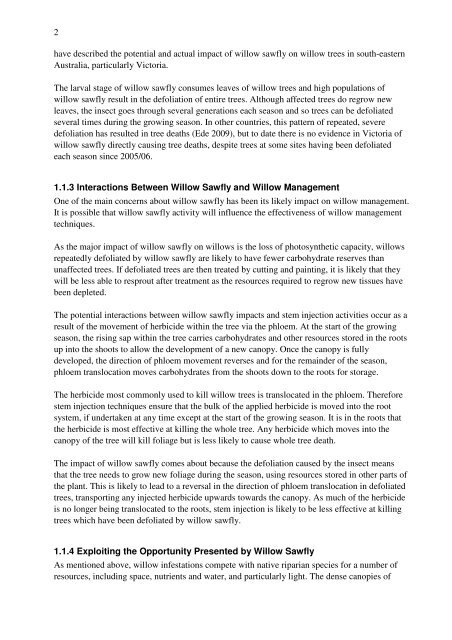Willow Sawfly Management Trials - Weeds Australia
Willow Sawfly Management Trials - Weeds Australia
Willow Sawfly Management Trials - Weeds Australia
You also want an ePaper? Increase the reach of your titles
YUMPU automatically turns print PDFs into web optimized ePapers that Google loves.
2have described the potential and actual impact of willow sawfly on willow trees in south-eastern<strong>Australia</strong>, particularly Victoria.The larval stage of willow sawfly consumes leaves of willow trees and high populations ofwillow sawfly result in the defoliation of entire trees. Although affected trees do regrow newleaves, the insect goes through several generations each season and so trees can be defoliatedseveral times during the growing season. In other countries, this pattern of repeated, severedefoliation has resulted in tree deaths (Ede 2009), but to date there is no evidence in Victoria ofwillow sawfly directly causing tree deaths, despite trees at some sites having been defoliatedeach season since 2005/06.1.1.3 Interactions Between <strong>Willow</strong> <strong>Sawfly</strong> and <strong>Willow</strong> <strong>Management</strong>One of the main concerns about willow sawfly has been its likely impact on willow management.It is possible that willow sawfly activity will influence the effectiveness of willow managementtechniques.As the major impact of willow sawfly on willows is the loss of photosynthetic capacity, willowsrepeatedly defoliated by willow sawfly are likely to have fewer carbohydrate reserves thanunaffected trees. If defoliated trees are then treated by cutting and painting, it is likely that theywill be less able to resprout after treatment as the resources required to regrow new tissues havebeen depleted.The potential interactions between willow sawfly impacts and stem injection activities occur as aresult of the movement of herbicide within the tree via the phloem. At the start of the growingseason, the rising sap within the tree carries carbohydrates and other resources stored in the rootsup into the shoots to allow the development of a new canopy. Once the canopy is fullydeveloped, the direction of phloem movement reverses and for the remainder of the season,phloem translocation moves carbohydrates from the shoots down to the roots for storage.The herbicide most commonly used to kill willow trees is translocated in the phloem. Thereforestem injection techniques ensure that the bulk of the applied herbicide is moved into the rootsystem, if undertaken at any time except at the start of the growing season. It is in the roots thatthe herbicide is most effective at killing the whole tree. Any herbicide which moves into thecanopy of the tree will kill foliage but is less likely to cause whole tree death.The impact of willow sawfly comes about because the defoliation caused by the insect meansthat the tree needs to grow new foliage during the season, using resources stored in other parts ofthe plant. This is likely to lead to a reversal in the direction of phloem translocation in defoliatedtrees, transporting any injected herbicide upwards towards the canopy. As much of the herbicideis no longer being translocated to the roots, stem injection is likely to be less effective at killingtrees which have been defoliated by willow sawfly.1.1.4 Exploiting the Opportunity Presented by <strong>Willow</strong> <strong>Sawfly</strong>As mentioned above, willow infestations compete with native riparian species for a number ofresources, including space, nutrients and water, and particularly light. The dense canopies of
















